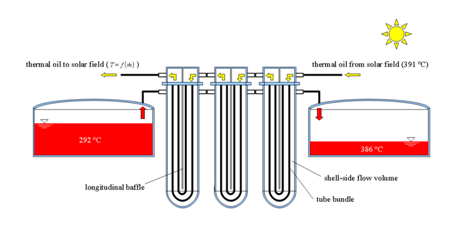Software for thermal storage
Short description
Due to the fluctuating nature of solar energy, solar thermal power plants often operate under transient conditions. Thus, whenever thermal energy storage (TES) is applied in these plants, also the storage system is subjected to transients. In many cases, the thermal inertia of the TES system limits the operation strategy of the whole plant, e.g. so that a short cloud pass cannot be balanced by the storage system, since it would take too long to switch from charging to discharging operation. In case of peaking operation of the plant, in order to cover low wind and photovoltaic output, the TES system should quickly reach steady nominal discharging operation, providing the heat preferably at constant temperature. Hence, when optimizing operation strategies the transient response of the TES system must be known.
In this context, the Solar Thermal Energy Department at CENER has been developing an extensive model library for the transient evaluation of TES on component level, as well as on system level (whole power plant performance). This allows the simulation of operating strategies and control loops that are very close to reality.
More information:
- F. Zaversky, Object-oriented modeling for the transient performance simulation of solar thermal power plants using parabolic trough collectors - A review and proposal of modeling approaches for thermal energy storage, PhD Thesis, Public University of Navarre, Pamplona, Spain, 2014 (http://academica-.unavarra.es/handle/2454/16705)
- F. Zaversky, M. Sánchez, D. Astrain, Object-oriented modeling for the transient response simulation of multi-pass shell-and-tube heat exchangers as applied in active indirect thermal energy storage
- I. Hernández Arriaga, F. Zaversky, D. Astrain, Object-oriented Modeling of Molten-salt-based Thermocline Thermal Energy Storage for the Transient Performance Simulation of Solar Thermal Power Plants, Energy Procedia, 69 (2015) 879-890
- F. Zaversky, J. Pérez de Zabalza Asiain, M. Sánchez, Transient response simulation of a passive sensible heat storage system and the comparison to a conventional active indirect two-tank unit, Energy, 139 (2017) 782-797
Main technical features
The model library has been developed applying the modeling language Modelica and includes conventional heat storage systems (active two-tank direct and indirect) as well as alternative approaches based on backed-bed thermocline storage or passive latent or sensible TES. Modelica is a multi-purpose physical system modeling language and has been developed in an international effort in order to unify already existing similar modeling approaches and to enable developed models and model libraries to be easily exchanged. The concept is based on non-causal models featuring true ordinary differential and algebraic equations, i.e. differential-algebraic equation (DAE) systems.
Innovative aspects
So far, most modelling procedures focus on quasi-steady models where transient responses cannot be reproduced. The main innovation of the modeling approach is the capture of the transient system behavior in detail, being able to improve operation and control of the solar thermal power plant.
Applications
The typical application would be the detailed analysis of operation strategies and control of any type of solar thermal power plant.
Related documents
Image gallery
Type of partner sought
Companies,Research organizationsTasks to be performed by the partner you are looking for.
Cooperation in terms of validation and demonstration of capabilities of software

